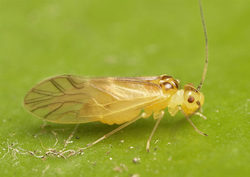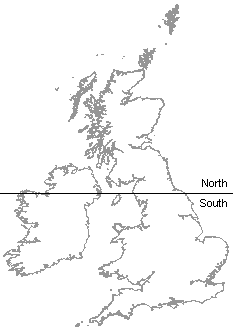BRC HOME » Barkfly » Introdution to barkflies
|
||||||||||
| Home | Introduction | Recording Scheme | Species Accounts | Key | Gallery | Literature | News Archive | ||||||||||
Introduction to barkfliesWhat are barkflies?Barkfly is the name given to species in the insect order Psocoptera which occur out-of-doors (cf. booklice – the indoor species). Why ‘barkflies’?You may not have come across the name barkfly before, which is not surprising since it was only coined in 2003. Keith Alexander proposed the name as an alternative to the previously used vernacular name of barklice. Why? As he put it, “I have started to refer to the arboreal species as "barkflies", as the term "lice" has such a bad name with people. If we wish to promote an interest in these delightful insects for their own sake then we do need an attractive vernacular name”. Recognising barkflies in the field
Valenzuela flavidus ©Brian Valentine Barkflies are relatively small insects (1.5 – 7mm) that, at a distance, usually have an overall grey colour. A few do have bright colours and one of the first species you will encounter, Valenzuela flavidus, has a bright yellow abdomen. Winged barkflies usually hold their wings in a tent-wise fashion over their abdomens and resemble miniature lacewings. These fully winged species can be confused with jumping plant lice (psyllids) which can be readily distinguished by gently touching them – psyllids jump away, barkflies don’t (or, on the rare occasions that they do, only manage a feeble hop). A number of species do not have full-sized (macropterous) wings but have ones that are much reduced (brachypterous) or absent (apterous). In the field the most likely group that these are confused with are springtails (which also jump away when touched). Beginners should also watch out for some small spiders which can have a superficially similar shape. A generally useful feature for all species is the domed postclypeus (the area at the front of the head between the antennae and mouth) which is visible with a hand lens. Other useful features to look out for are the long filiform antennae, the simple wing venation with the characteristic two ‘triangular’ cells at the tip of the forewing, and a pronounced tendency to run rather than fly away. HabitatsBarkflies feed on various ‘microflora (algae such as Pleurococcus, lichens and fungi) or on more general organic ‘debris’ which often occur in profusion on surfaces of bark or foliage of trees. The vernacular name emphasises this association and barkflies can be found on a wide range of broad-leaved and coniferous tree species. Some trees are more productive than others and the greatest diversity and numbers of barkfly species are often found on oak, beech, yew, pine, elder and hawthorn. Ash, sycamore and lime usually have a low diversity of species. A particularly good diversity of species can often be found by searching mature standards in old parklands. The foliage of trees represents a distinctly different niche to the bark and in particular the trunks. As a result, beating tree branches will often result in a quite different assemblage of species to that obtained by sampling tree trunks. The beating of dead aerial branches can be particularly productive. But not all barkflies are associated with trees and searches of low vegetation, leaf litter and under stones, for example, are necessary if a complete fauna for an area is to be achieved. Searches of these habitats are often unproductive but are required if the genuine status of the associated species is ever going to be determined. The habitat and microhabitat associations sections in the Species Accounts provides details of where species have been found based on British and Irish records. Many of the species are likely to occur in more microhabitats than those listed and the information will be updated periodically. Phenology
Dividing line between The breeding cycle of barkflies varies from species to species – most are single or double-brooded but a few breed continuously. Consequently, even during the winter some adults can be found of these latter species. A small number of species become adult in the spring (most notably Mesopsocus spp. and Loensia fasciata) but the adults of the majority of species appear in late summer and autumn. August and September are the best months for recording barkflies. As with other taxonomic groups the earliest and latest dates that adults appear varies across the country. In order to give an indication of the extent of this variability the adult date ranges in the species accounts are given for north and south areas of Britain and Ireland. The dividing line between these two areas is at 500000 metres using the British National Grid coordinate system (approximately 54° 24' N latitude - roughly North Yorkshire-Lake District extending across Northern Ireland).
The species accounts provide two types of adult phenology data - the extreme dates
(i.e. the earliest and latest sightings) and the main date range. The period that
adults are present varies from year to year and the main date range indicates the
period when they can usually be seen (though there are local factors such as altitude
that can affect this). For some species there are currently insufficient data (less
than 50 records) to determine the main date range and 'Unknown' has been entered
in the species accounts. Several barkfly species have two or more broods per year
and there can be periods within the main date range when adults are more or less
absent e.g. Elipsocus hyalinus is rarely seen in July in the north. Sampling techniques
Bark brushing ©Val Muirhead The main technique for collecting barkflies is by beating tree branches with a stick and catching the falling insects onto a beating tray (or, if you haven’t got one, an upturned umbrella). Barkflies rarely fly so collecting specimens from the tray can be carried out in a fairly leisurely way (which is not the case for some other insect groups). A convenient way of sampling tree trunks is to push a beating tray against the trunk and, using a large soft brush (e.g. wallpaper paste brush), brush down the trunk catching any specimens on the tray. Walk slowly around the trunk brushing as you go, using the edge to get into crevices and the flat on the smoother bark. The sampling of a mature trunk takes about one minute. These two techniques will allow most species in an area to be sampled, but not all of them. Other techniques that may turn up different species are sweep-netting, litter sieving (including sieving of old nest material), malaise trapping, vacuum sampling, brushing flakes of removed bark and simple observation e.g. of undersides of stones. All specimens need to be stored in 70% alcohol – dried specimens can be very difficult to identify. IdentificationYou will need access to up-to-date identification keys and a binocular microscope to identify specimens. Fortunately access to the keys is straightforward because in 2005 Timothy New revised his handbook and keys to all the currently known British species (except one - Atlantopsocus adustus) are included. Most species can be identified without too much difficulty from external characters such as wing venation – thankfully, very few require dissection for identification to be possible. Anyone who is not keen on learning to identify species should still collect specimens – they can then be sent to the recording scheme organiser for identification. Statuses
As with all taxonomic groups certain species are common (e.g. Graphopsocus cruciatus
and Valenzuela flavidus) while others are rarely encountered (e.g. Hyalopsocus
morio has not been seen in Britain since 1867).
The current status of each species is shown in the species account
summary sections. The status of a species often varies in different countries e.g.
the status of Stenopsocus stigmaticus, Uncommon in England and Wales, indicates
that the species has not been recorded in Scotland or Ireland. Britain is used to
mean England, Wales and Scotland; as far as statuses are concerned Northern Ireland
is included in ‘Ireland’.
|